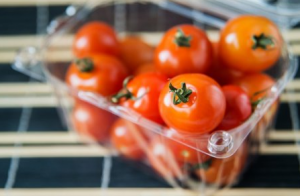 At present, biobased plastics are rarely used in injection moulded food packaging, such as salad or butter containers. A new research project aimed at price-competitive food packaging based on biobased plastics wants to change this. The specific challenge of the new project is to produce thin walled transparent food packaging via injection moulding, using biobased plastics that are usually too viscous for this application.
At present, biobased plastics are rarely used in injection moulded food packaging, such as salad or butter containers. A new research project aimed at price-competitive food packaging based on biobased plastics wants to change this. The specific challenge of the new project is to produce thin walled transparent food packaging via injection moulding, using biobased plastics that are usually too viscous for this application.
Although food producers are interested in biobased plastic packaging, injection moulded salad, butter or tomato containers are not available on the market on a large scale. “The interest in biobased packaging decreases dramatically when people calculate what the switch to these materials would cost,” says Gerald Schennink, senior polymer scientist at Wageningen Food & Biobased Research. This is also the experience of Niels L’Abée, director of SFA Packaging. “From clients we see no explicit willingness to pay extra, but at the same time everyone feels that there should be more environmentally friendly packaging available. This trend is even more evident among consumers.”
Injection moulding thin walled biobased plastics
With the above in mind, L’Abée and Wageningen Food & Biobased Research took the initiative to study whether commercially available biobased plastics could be made more suitable for this type of application. A public private research consortium funded by the Dutch government’s Agri&Food Top Sector and also including Arburg BV and TN Plastics BV, was recently established with this goal.
There are several biobased plastics on the market, and most are suitable for film applications. Schennink: “Ideally, food packaging films must be strong and stiff . Polylactic acid (PLA), that is biobased by origin, possesses these properties. Production of an injection moulded food packaging demands different material characteristics, however.” Complex shaped food packaging can be produced via injection moulding, in which molten plastic is injected and subsequently cooled down in a mould. Commercial available biobased polyesters do not flow easily, and therefore one-to-one replacement of conventional plastic with biobased plastic is difficult.
Thinner and cheaper
The new project focuses on three innovations. The first involves the use of additives that improve the flow behaviour of biobased plastics. Secondly, the project partners will look into more sophisticated production procedures. A possible concept is not to close the mould entirely, but inject the plastic first and close the mould after some specific time. This so-called injection compression moulding technique isn’t new. However, it has yet to be determined whether it leads to the desired biobased plastics – food packaging with thinner walls than conventional plastics so that less plastic is required and the costs of biobased products can be reduced. “This is where the mechanical properties of biobased plastics are an advantage,” says Schennink. “They are often more stiff than fossil based plastics. ” A thin wall is essential in this project as it is the only way reduce material use.
Extra layer
The third focus point are the barrier requirements of the packaging . As well as keeping products clean, a container for cookies also keeps them fresh since hardly any water vapour will permeate through the packaging. “We will not be able to achieve this with polylactic acid as its water vapour barrier is limited,” says L’Abée. “We will try to add an extra layer in the container that provides the required barrier properties”. Although this sounds complicated, multi-layered food packaging is quite common. An extremely thin printed film is pressed into the mould and fuses with the plastic to provide an imprint on the packaging. This technology – in-mould labelling – is already applied in various packaging products.
The final goal of the project is to develop profitably biobased plastic packaging with around half the CO2 emissions in material and production per unit as compared to conventional plastics. It would also offer consumers the opportunity to select a ‘greener’ alternative. l’Abée: “Consumers don’t have that choice at this time as at present there is no alternative. In the future, the product may cost a little more, but the market will show whether consumers are willing to pay for environmental benefits.”
Contact
Source
Wageningen University, press release, 2017-06-29.
Supplier
Arburg BV
TN Plastics BV
Wageningen University
Share
Renewable Carbon News – Daily Newsletter
Subscribe to our daily email newsletter – the world's leading newsletter on renewable materials and chemicals









